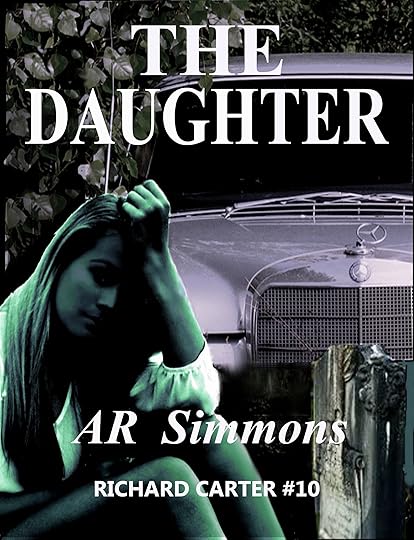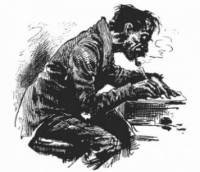A.R. Simmons's Blog: Musings and Mutterings, page 12
March 30, 2016
My Preview Hot Mess or How I Shot Myself in the Foot
 I must begin this article with an apology. Some of you had the misfortune of trying to view previews of my novels, and still had the grace not to say, “You dolt!” I could plead ignorance, but that would be stating the obvious. To make a long story short, when I began the previews, I must have uploaded something other than the PDF files that Goodreads requires. The result was files with a nice cover illustration, but with painfully slow pagination which sent the would-be reader through all the front matter. The formatting was also wrong, resulting in an extremely amateurish and sloppy presentation.
I must begin this article with an apology. Some of you had the misfortune of trying to view previews of my novels, and still had the grace not to say, “You dolt!” I could plead ignorance, but that would be stating the obvious. To make a long story short, when I began the previews, I must have uploaded something other than the PDF files that Goodreads requires. The result was files with a nice cover illustration, but with painfully slow pagination which sent the would-be reader through all the front matter. The formatting was also wrong, resulting in an extremely amateurish and sloppy presentation.I removed all those old “neverviews,” and replaced them with real meat. Each preview runs from 75 to 85 pages, compared to the 45 pages or so you get on one of my Amazon Look Insides. I end each preview with a complete scene instead of cutting you off in the middle of something. If you were disgusted with the previews earlier, give me another chance.
A Character You Probably Know
 “The aging and lonely Preslar probably harbored hope that the pretty young coed would find him, an overweight, snuff-dipping peckerwood twice her age, as attractive as he found her. It was pathetic but also pitiable.”
“The aging and lonely Preslar probably harbored hope that the pretty young coed would find him, an overweight, snuff-dipping peckerwood twice her age, as attractive as he found her. It was pathetic but also pitiable.”—The Daughter (© 2015)
You don’t have to have grown up in these hills to be familiar with people like Steve Preslar, known to most of us as “Stevie.” Of course, if you want to see our Stevie in his native habitat, drop by during “hillbilly holy week” (that would be deer season). You’ll likely find him in deer camp with his runnin’ buddies drinking, playing poker, and either barbecuing or making camp stove chili.
It’s not necessary to make a special trip to Hawthorn County though. Drop into the neighborhood bar or pub, the gas station at the crossroads, a downtown coffee shop, or an uptown bistro, and you’ll likely find him there. He’s the perennial “good ole boy,” aptly named because he is destined to never grow up. He will go straight from being a teenager to being a middle-aged man without navigating any rite of passage.
If he’s intolerant, sometimes belligerent, and often insufferable, he’s also the first to help should you have car trouble in the middle of the night. If you’re a “lady” or an elderly person, he’ll change your tire in the pouring rain. He’s the first to begin a search for a child lost in the woods, and the last one to give it up. He’s never been in the service, mind you, but he’s as patriotic as all get out. His bigotry and misogyny can’t really be excused by saying that he’s lonely, unfulfilled, and bitter, nor should it be, but those are contributing factors.
You may think him eccentric, but Stevie is no outlier. In a way he’s the best and worst of us—us being the common people. And yes, I did say he’s the “best” as well as the worst of us. That’s because Stevie knows no middle ground. He is all extremes. He’s dog loyal and loves his buddies, but he would never say he “loves” them. He doesn’t use that word except for food and drink.
For the big problems in life, he reflexively advocates cutting the Gordian knot (although he’s never heard the term). His foreign policy is “nuke ‘em if they mess with us.” His domestic policy is—well, let’s not get into that. I would have to write terms and epithets that I am uncomfortable with repeating, and I’d have to in order to adequately convey Stevie’s meaning.
You might think him despicable, but I can vouch one thing for him: he would never intentionally harm a woman, child, or dog, and he’s ready to hang anyone who would.
I’ll bet you know him—but your "Stevie" probably speaks with a different accent.
Published on March 30, 2016 08:02
March 23, 2016
The Evolution of the Series (10) The Daughter
 I hope that by now, you have at least read Bonne Femme and Cold Tears (prequels). Of course, as with all series, it’s most enjoyable to read them in order, but I assure you that The Daughter is a stand alone story.
I hope that by now, you have at least read Bonne Femme and Cold Tears (prequels). Of course, as with all series, it’s most enjoyable to read them in order, but I assure you that The Daughter is a stand alone story. Every story is about people and relationships and the dramas of life. Whether it is set in a mythical recent past, the gritty present, a post-doom dystopia, a distant galaxy, a fantasy world peopled by strange, wonderful and terrifying beings, it must speak to us of us.
The Daughter features several relationships: the missing Shara McGregor and her mother Okinawa, Okinawa and her friend Willis Sparkes, and, of course, Richard and Jill along with their daughter Mirabelle. I also brought back Jill’s friend from college (Bonne Femme) Marta for this story.
I began the series with Bonne Femme, a book all about obsessions, one that drove Richard, and one that drove his nemesis. Each of the stories has featured at least a pair of conflicting obsessions, as does this one. Richard, of course, carries his with him. How can he not? It is key to what he is.
About the title: we only see Shara through the eyes of those who knew her, and through Richard’s too-vivid imagination. Remember, Richard has a daughter of his own.
In these stories of obsessions, the criminal's always drive the plot, but the obsessions of the victims often take the wheel also. In Cold Fury, the motive for the crimes did not become apparent until the climax scene. In The Daughter, the motive of the criminal seems obvious from the start. The mystery then is to find the culprit of course. However, as any cop can tell you, knowing “who done it” and proving it are two different things. So we had to go through a trial which gave me pause. I had never written a courtroom scene. Not to worry, the above is no spoiler. Finding the truth is not a mere dotting of the I’s and a crossing of the T’s. The Daughter is a puzzle, but not a crossword to work out, or a jigsaw puzzle to piece together. It is a hand puzzle that suddenly comes together on its own.
I enjoyed the heck out of myself while writing it, and I think you will enjoy it too.
https://www.goodreads.com/book/show/2...
Published on March 23, 2016 09:26
•
Tags:
disappearance, investigation, murder, mystery, obsession, relationships, series, strong-female
March 9, 2016
Ethics: Truth in Advertising

A writer’s trust and reputation are precious things. When broken, trust is gone. When ruined, reputation is almost impossible to repair. The thing is, only you can break the trust people have in you, and only you can ruin your reputation. One sure way to do both is to lie about yourself and your work.
Don’t say you are a best-seller when you are not. Don’t try to represent yourself as on a par with James Patterson, Faye Kellerman, or any other successful and famous author. They have earned their reputations and paid their dues.
Until you become a best-selling author (you/I should live so long), you’re body of work must speak for you. You may have a story that is brilliantly written, perhaps better than the average story written by a best-selling author. Perhaps it deserves acclaim, but it is not internationally acclaimed because you think it should be. Please be careful about the use of superlatives to describe your literary efforts. Amazon has an editorial review section for you to place excerpts from favorable reviews. Two things to keep in mind: correctly identify the source of the quotes, and remember that people will consider the source, as they should. A major trade publication review or a NYT review, for example, trumps one from a lesser known book blog. Book blog reviews can be impressive or not so much. The unethical writer might be tempted to fake a review and give a false citation. That could, and should, get him put on a “don’t read” list. Come on! An author cannot review himself.
Now about the conventional third person bio you wrote. Okay, so it’s pretentious to speak of yourself in the third person, but it is traditional and expected. So be it. But let’s be real here. Tell the truth about yourself. You can just tell the good parts, but emphasize, don’t distort. You took a trip to Europe. Fine, that doesn’t make you a world traveler. You worked as third assistant circulation director for your local newspaper. That doesn’t make you a journalist. So remember to emphasize the truths that make you interesting, but a biography shouldn’t be a complete work of fiction.
Best seller? On whose list? Award-winning? Which award? Internationally acclaimed? By—well, you get the idea.
Published on March 09, 2016 16:33
Shara McGregor
image: 
This cover for the tenth novel has three elements: Shara McGregor (Blue Creek's "golden girl"), an abandoned Mercedes (her mother's car), and the headstone in an isolated grave yard in the "Irish Wilderness" of the Missouri Ozarks. The car should not be there, and Shara shouldn't be where she is.

This cover for the tenth novel has three elements: Shara McGregor (Blue Creek's "golden girl"), an abandoned Mercedes (her mother's car), and the headstone in an isolated grave yard in the "Irish Wilderness" of the Missouri Ozarks. The car should not be there, and Shara shouldn't be where she is.
Published on March 09, 2016 05:16
•
Tags:
character, pic, the-daughter
March 2, 2016
Richard Carter In James Mill
 The next time I saw Carter, he was holed up in a basement, playing video games and neglecting to eat, work, or take care of himself. He’d descended into a sort of limbo while his young wife was attending the funeral of her Aunt Mirabelle in France. Without her, he just couldn't hold it together.
The next time I saw Carter, he was holed up in a basement, playing video games and neglecting to eat, work, or take care of himself. He’d descended into a sort of limbo while his young wife was attending the funeral of her Aunt Mirabelle in France. Without her, he just couldn't hold it together.They had fled Michigan and notoriety shortly after he and Jill married. He was no longer the naïve young man who left home for the Marines, nor was he the disillusioned soldier trying to make his way in the real world.
The traumatic events in Cartier left him with his dream of an FBI career dead. Jill was his lifeline, but he was barely hanging on. To his PTSD and guilt is added a suspicion that he is holding his wife back from her promising career.
He drifted from one menial job to another, taking little interest in the routines of daily life. Increasingly, he worried that Jill was only staying with him out of gratitude for saving her life.
Jill knew all this, but was at a loss as to how to reassure him. In truth, she was exasperated with his inability to do anything but drift. When he finally did find something that holds his attention and interest, however, she was alarmed rather than reassured. She feared that his promise to help the single mother with a missing baby would end in failure and plunge him into a despair from which he might never recover. She had all but lost faith in him.
Richard, however, was an increasingly willing “godsend.” Once he had given his word, he would see his duty through to the end. As depressing as his hunt for the truth might be, the prospect of doing something approximating detective work exhilarated him.
Published on March 02, 2016 03:36
•
Tags:
character, cold-tears, richard-carter
February 1, 2016
The First Time I Saw Richard Carter
 Oddly, the most important thing I saw is prologue. Unfortunately for Richard, it is a fact neither to be undone nor forgotten. For him, as for all of us, the past is—not was.
Oddly, the most important thing I saw is prologue. Unfortunately for Richard, it is a fact neither to be undone nor forgotten. For him, as for all of us, the past is—not was.The first time I saw him, he was wading ashore with his Marine squadmates in Somalia. He was young, naïve, and optimistic. Like his country, he hoped to set things right.
I was with him too that day when death spun out of an alley, provoking the instant decision that destroyed most of what he assumed the world to be. His innocence evaporated in an obscene burst of automatic rifle fire. What he did not know, could not know at the time, was that he retained the essence of his integrity. Like the hope that Pandora loosed on the world, his integrity intensified his self-loathing and his guilt. He refused to consider that it was something that happened to him. For him, it was something that he did.
What I remember most vividly of the days that followed is Richard’s uncertainty. He was uncertain of almost everything, including his own sanity. Why wouldn’t he be? Willingly or not, he broke the oldest taboo. Circumstance, society, even God might forgive him, but he could not forgive himself.
Nothing made sense to him anymore because what he felt in that Mogadishu street wasn’t something a real man would feel—unless he was a monster.
It wasn’t because he pulled the trigger. It was because of the elation afterwards.
Richard is no monster, no matter how much he sees himself as one. But he has a demon, and its name is PTSD.
I watched him as he tried to come home.
And then he betrayed his “dream girl.”
Published on February 01, 2016 11:04
•
Tags:
bonne-femme, character, ptsd
August 21, 2015
What You Can Expect, (And What You Cannot)

As all authors do, I get reviewers who are disappointed to a minor or major extent with my stories. The hard fact is that not everyone has the same tastes. I’m not referring to the objective criticism of grammar, overuse of clichés, or plot holes. There really is no excuse for those and no defending them. What I am referring to is the kind of criticism that comes from matters of taste, things like amount of back story, number of characters, extraneous details, side stories, and overall length of the book. On the last point, it still amazes me to read something like “The book went on for 400 pages.”
Personally, if I enjoy a book, I’m in no hurry to see it end. Nevertheless, in the end, a story either works for a reader or it does not. So let me tell you what to expect and what not to expect as far as plot, setting, characters, and length of the books in the Richard Carter series.
Do not expect a simple linear plot without back story or minor stories to augment the reality of the main one. First, this is a series, and the back story is very important both to understand the relationships between the protagonist characters, Richard, Jill, and Mirabelle Carter, Shug Shively, Ron Guidry, Shane and Raven Sander, and Carl Hoag. Each of the characters is introduced in a novel and becomes important to the two main protagonists, Richard and Jill. Although it is best to read the series in order, I’ve added enough back story to make each of the novels a stand-alone. It’s always a balancing act of providing enough information about a character without wearying the reader familiar with them from previous stories.
A second stylistic point that some have objected to is collateral story lines. I think that characters are more interesting if they have pasts and problems instead of just being described by what they say and do. I also think that a mystery should have not only “red herrings,” but also slices of life that may or may not have to do with the mystery. After all, doesn’t a real detective have to consider things that may or may not be directly related to his case? Expect not to know, for example that another suspicious death is related to the murder being investigated. Every element adds to the story, but it may not help to unravel the mystery. It might in fact muddy the water for the investigator.
Setting and characters go hand in hand. I try to always convey a good feeling for time and place. I want the reader to picture the setting. I want him or her to experience the contemporary Ozarks. My main characters are assimilating to small town and rural life. Richard is from small town Michigan, Jill from Brittany, Ron Guidry from New Orleans, and Carl Hoag from New York. Each has washed ashore in Hawthorn County for their own reason, each reason important to an understanding of the character. Shug Shively, Richard’s boss is the only “home grown” character. The other characters are a mixture of life-long Ozark residents and “transplants,” exactly as you would find there and I expect, almost anywhere.
A further note about characters: I use a lot of them, some only for a short incident in the story. My feeling about that is that a named and rounded character is more interesting than an unnamed one no matter how well defined. I always provide a list of characters at the end of the book for reference in case the reader puts the book down and comes back much later. I can’t imagine anyone immersed in the story forgetting who a particular character is, and immersion is what I aim for.
As far as “extraneous” information and length of the story, all I can say is that the detail is part of the story. Some of the characters are colorful, some eccentric. My method is to pattern them after people I have met, only changing them by exaggerating some characteristics and down-playing others. Again, the motivation is to entertain. If I use a “stock character,” (and who doesn’t?) then I try to have him or her act and speak in a way to make them less “stock.”
A further explanation (or warning), is that I do not find superheroes very believable in my genre. Many of my Fantasy, Paranormal, and Graphic Novel author friends use them quite effectively, but I find that real heroism is only possible if done by a person of ordinary abilities who acts despite his or her fears. That leads me to another point of what you can expect. I consider the most heroic characters in the stories women, especially Jill and Raven. So I was shocked the first time I was charged with sexism by a reviewer. (I got a rating of two stars!)
After a point-by-point rebuttal of the charge (in my mind only), I decided to consider seriously what I was being accused of. When I did, I saw the point of the reviewer. One of my main characters was a stay at home mom who fell apart after her husband was killed. I described her as a petite blonde. Another main character, Jill, Richard’s wife is a professor at the local community college who sees the most important thing in her life, not her career, but her young daughter and her husband. All I can say is: get to know the women in the series and then see if you still think me sexist.
For blurbs, small excerpts >>> https://mrarsimmons.wordpress.com/
Published on August 21, 2015 04:11
March 22, 2015
Ethics: Literary Theft

This is the first of a series of articles on writers’ ethics. Please pardon the informal grammar. I intend to be chatty.
I’ve never posed as, or claimed to be, an authority on writing. However, ethics seems simple enough to me. It means doing the right thing, doesn’t it? So let’s see if we can apply it. Let’s start with plagiarism.
Recently a judge on the TV show The Voice was accused of it. Pharrell Williams (a musical genius who I greatly admire) and Robin Thicke were ordered to pay $7 million to the estate of Marvin Gaye for “Blurred Lines” being a copy of “Got to Give it Up.” A few years back, the owners of Australian classic “The Kookaburra Song” won a suit against Men At Work for lifting a riff used in “Down Under.” Was either real plagiarism? I can’t judge, but it suggests that it is all too easy to take other people’s work as our own.
In the age of cut and paste, one can lift entire passages of other people’s work and drop them into their own. Well, if you do something that bald-faced, no amount of ranting will faze you, and you are not a writer anyway. However, word-stealing is not the only form of literary theft. Expropriating whole plot ideas is also plagiarism, as is cloning characters. (I’m not sure where fan fiction fits into all this, but it seems a bit iffy to me.)
For me, this is a little tricky because I’m a natural mimic. A professor once told me that my essay on “Paradise Lost” sounded too much like Milton. Now, my practice is not to read fiction while writing fiction. Perhaps because of my penchant for mimicking, I prefer to think of this as unintentional or (even milder) inconsequential “borrowing.”
I know that it’s a little more complicated than that. Shakespeare wasn’t the originator of Romeo and Juliet. (One earlier version was Los Dos Amantes de Teruel, and the earliest came from Boccaccio ). The Bard, however, was writing a screen play, so perhaps we could call it an adaptation.
Let’s conclude with a bit of advice: develop your own writer’s voice, use settings that you know (that includes the ones you create), and only google for fact checking. And as my old dad used to say, “If you take something that doesn’t belong to you, you’re a thief.”
As always, correcting my ignorance and mistakes is welcome—but be gentle.
Published on March 22, 2015 15:27
•
Tags:
ethics, plagiarism
January 14, 2015
On Genre Formulae
 Readers and authors, I have a question for you. Must a story in a particular genre adhere strictly to a formula? Is there some rule, for example, that a mystery must have x number of plot twists? Must the protagonist follow some requisite assortment of false leads? Must the reader be totally dumbfounded when he discovers (on the last page) who done it?
Readers and authors, I have a question for you. Must a story in a particular genre adhere strictly to a formula? Is there some rule, for example, that a mystery must have x number of plot twists? Must the protagonist follow some requisite assortment of false leads? Must the reader be totally dumbfounded when he discovers (on the last page) who done it?I don’t pretend to answer these questions definitively. What follows is merely my opinion.
I don’t like formulae. They are confining, and confinement is the enemy of creativity. However, the reader has a right not to be the victim of false advertisement. If he buys a thriller, by golly, he wants to be thrilled. If he buys a mystery, he wants to be mystified (at least for a good portion of the story). If it’s horror, he expects to be frightened. If adventure, thrilled. If . . . Well, you get the picture. But a story goes where it will. At least, mine do.
The hardest genre for this author is mystery. The reason for that is the expertise of mystery readers. A dedicated aficionado is almost impossible to mislead for an entire book. They’re sharp and very experienced. You had better not try to fool them by some gimmick or “tomato surprise.” They will often figure things out midway through. The author’s only recourse then is to make them say to themselves, “Well, maybe not.”
I don’t concern myself with it too much, because I think a good story will save the day. I try always to increase the tension near the end. If I can carry the reader through to a breath-taking ending, he will enjoy the book, and then congratulate himself on knowing that he was a better investigator than the protagonist.
My only formula, whether I’m writing mystery or a thriller is to give the reader someone to be, someone to love, and someone to fear. A new plot? There are none. The Greeks invented them all (or stole them.
Musings and Mutterings
Posts about my reading, my writing, and thoughts I want to share. Drop in. Hear me out. And set me straight.
- A.R. Simmons's profile
- 59 followers



